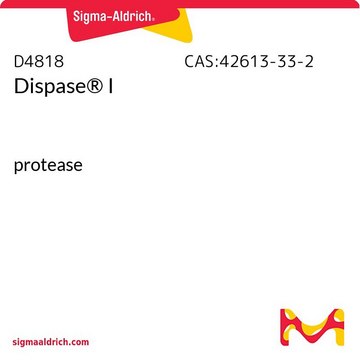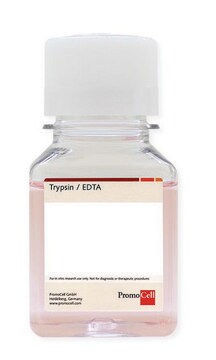04942086001
Roche
Dispase® I (neutral protease, grade I)
lyophilized, ≥10 units/mg protein (20 U/vial (37 °C, casein as substrate, pH 7.5)), optimum pH 6.0-8.5
About This Item
Productos recomendados
biological source
Bacillus polymyxa
Quality Level
form
lyophilized
specific activity
≥10 units/mg protein (20 U/vial (37 °C, casein as substrate, pH 7.5))
packaging
pkg of 10 × ~2 mg
manufacturer/tradename
Roche
concentration
0.6-2.4 U/mL
technique(s)
tissue processing: suitable
color
white
optimum pH
6.0-8.5
solubility
water: soluble
application(s)
life science and biopharma
sample preparation
shipped in
wet ice
storage temp.
2-8°C
General description
Specificity
Application
Features and Benefits
- Rapid, effective, yet gentle agent that liberates intact cells
- Maintains cell membrane integrity
- Non-mammalian source - free of mycoplasma and animal virus contamination
- Extremely stable to influences of temperature, pH, and interference by serum components
- Easily inactivated by chelating agents or by dilution
- Delivers higher activity and convenience
Contents
10 vials with approximately 2mg each (= 20U/vial).
Specifications
Inhibitors: EDTA, EGTA, Hg2+, other heavy metals. Dispase is not inhibited by serum.
Unit Definition
A practical comparison of RAS units of Dispase® with those cited in the Japanese literature (where concentrations of 1,000 to 2,000 Dispase® units /ml are not uncommon) suggests one Roche Applied Science unit of Dispase® I equals approximately 416 Japanese units of Dispase®.
One unit of Roche Applied Science Dispase® equals 181 protease units (PU) measured as release of amino acids equivalent to 1 μg tyrosine per min and ml at pH 7.5 and +37 °C.
Physical form
Preparation Note
Working concentration: 0.6 to 2.4 U/ml
Working solution: Preparation of stock and working solutions:
To produce a 10 mg/ml stock solution, dissolve the lyophilized Dispase® I enzyme in HEPES-buffered saline (50 mM HEPES/KOH pH 7.4, 150 mM NaCl). To produce the working solution, dilute the above stock solution with the culture medium for the isolated cells, at a final concentration of 0.6 to 2.4 U/ml. Note that concentrations higher than 2.4 U/ml are not recommended. For best results, filter the working solution using a 0.22 μm filter membrane.
Storage conditions (working solution): -15 to -25 °C
The reconstituted stock solution is stable at 2 to 8 °C for 2 weeks. For storage up to 2 months, the stock solution should be frozen in aliquots. Avoid repeated freezing and thawing.
The working solution diluted with PBS is stable at 2 to 8 °C for 3 days.
Storage and Stability
Other Notes
Legal Information
signalword
Danger
Hazard Classifications
Eye Irrit. 2 - Resp. Sens. 1 - Skin Irrit. 2 - STOT SE 3
target_organs
Respiratory system
Storage Class
11 - Combustible Solids
wgk_germany
WGK 1
flash_point_f
does not flash
flash_point_c
does not flash
Elija entre una de las versiones más recientes:
¿Ya tiene este producto?
Encuentre la documentación para los productos que ha comprado recientemente en la Biblioteca de documentos.
Los clientes también vieron
Artículos
Enzyme Explorer Key Resource: Collagenase Guide.Collagenases, enzymes that break down the native collagen that holds animal tissues together, are made by a variety of microorganisms and by many different animal cells.
Contenido relacionado
Collagenase Guide.Collagenases, enzymes that break down the native collagen that holds animal tissues together, are made by a variety of microorganisms and by many different animal cells.
Nuestro equipo de científicos tiene experiencia en todas las áreas de investigación: Ciencias de la vida, Ciencia de los materiales, Síntesis química, Cromatografía, Analítica y muchas otras.
Póngase en contacto con el Servicio técnico











